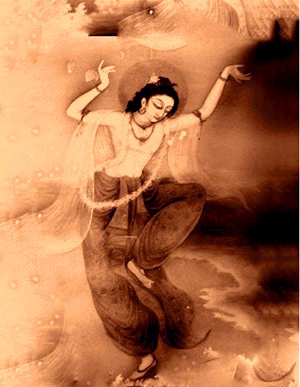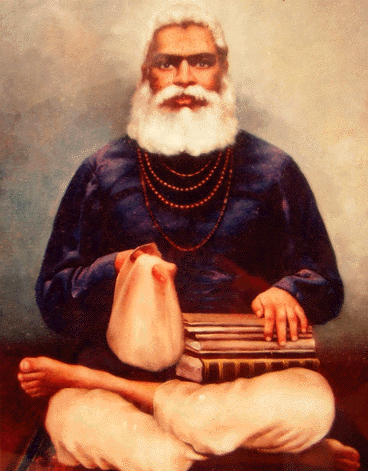Sri Sanmodana Bhasyam, Part 18
BY: SUN STAFF
Jun 16, 2016 — CANADA (SUN) — The last of a commentary on Lord Caitanya’s ‘Siksastakam’ by HDG Srila Bhaktivinoda Thakur, with a Bengali song for each verse that expands upon Mahaprabhu’s devotional moods (Sanskrit, 1886).
Lord Krsna desired to know, “How glorious is Srimati Radharani’s love for Me, She being My internal spiritual potency? How does She alone fully relish My transcendental qualities? What is the happiness She feels when She realizes the sweetness of My love for Her?”
Longing to answer these three questions, the Supreme Lord Sri Krsna revealed His eternal form as Sri Caitanya Mahaprabhu, Who personifies audarya or magnanimity in absolute fullness. Sri Caitanya savours to their mysterious depths the three states of Radharani’s love as He performs manifold pastimes in an exclusive region of Goloka known as Sri Navadvipadhama.
Adorned with the ecstatic sentiments and lustrous complexion of Srimati Radharani, Krsna as Sri Caitanya Mahaprabhu appears on this earth once in a day of Brahma. His most recent descent to the mortal plane occurred in the year 1486 of the Christian era in the West Bengal district of Nadia, where the divine waters of Mother Ganga purify the town of Navadvipa. Navadwipadhama is non-different from Vrindavana.
He took His birth during a full lunar eclipse on the bright moon night of the month of Phalguna (March). The whole town of Navadwipa was reverberating with the chanting of God’s name, as this was the custom during a lunar eclipse. The Lord accepted Pandit Jaganatha Misra and Srimati Sacidevi as His father and mother.
His childhood was filled with childlike restlessness and miraculous pranks; His boyhood days were spent in studies; His marriage in youth was strictly in accordance with Vedic culture as was His execution of household life. Thereafter He went to Gaya and accepted spiritual initiation in the ten syllable Gopal mantra from Sripad Isvara Puri, a great acarya in the Brahma-Madhva disciplic succession; thus He taught the living entities their duty to take shelter of a self-realized spiritual master as directed in the scriptures. After His return from Gaya He performed congregational chanting of the holy name with His associates and devotees, flooding Bengal with the nectar of the holy name of God and propagating devotional service to Krsna.
At age twenty four He received sannyasa initiation from Sripad Kesava Bharati of the Sankara sampradaya and forever severed all links with home and family life. The next six years found Him on pilgrimage through Bengal, Orissa, South India, Maharastra, Uttar Pradesh (Mathura, Vrindavana, Prayag, Kasi), and Bihar (Kaukai, Natsala, Rajmahal).
In His travels He blessed millions of conditioned souls by giving them the holy name of Krsna and teaching them the science of pure devotion. He refuted all philosophical speculations contradictory to the conclusions of the authorized scriptures and firmly established the philosophy of acintya bheda-abheda tattva, which He Himself taught for the first time as the essence of the teachings of the other four schools of Vaisnava philosophy.
For the next eighteen years He made His residence at Sri Jaganatha Puri. There, in the company of His intimate associates, He relished the nectar of love of Godhead, exploring fully the three questions. From amongst His followers, He sent out powerful preachers to lead the conditioned souls along the path of pure devotional service to the Supreme Lord.
In this way He drowned entire India in the waves of Krsna Damodara, Sri Ramananda Raya, Sri Prabhodananda Saraswati, Sri Rupa Goswami, Sri Sanatana Goswami, Sri Raghunatha dasa Goswami, Sri Gopal Bhatta Goswami, Sri Jiva Goswami, Sri Kavi Karnapura and others to write books establishing His teachings; for this purpose He impregnated their hearts with His divine potency.
He has personally condensed these selfsame teachings into His eight Sikshastaka prayers; they reach out and touch all levels of devotees. At times the Lord would immerse Himself in the nectar of these eight slokas, tasting their conclusions in the association of Srila Svarupa Damodara and Sri Ramananda Raya. Later, these slokas were explained in great detail in important scriptures like Sri Caitanya Caritamrita.
By His own example, Lord Caitanya taught how to lead an ideal householder life and the life of strict renunciation, sannyasa. These teachings too are all contained in these eight verses. They are superexellent. Surrendered souls who read with devotion these nectarean prayers from the mouth of the Supreme Lord Gauranga will certainly be attracted to the honey of Lord Caitanya’s lotus feet. Like spiritually intoxicated bees, they will swarm to the lily filled lake of Krsna’s love.
Four hundred and one years after the advent of Lord Gauranga, the commentary known as Sri Sanmodana Bhasyam was composed by Kedarnatha Bhaktivinoda. The Siksastaka prayers particularly distill the essence of all Vedic scriptures for the taste of the rasikabhakta, the pure devotee. Having emanated from the lips of the Supreme Lord Himself, these prayers are the Absolute Truth. They should be read, recited and worshipped daily by sincere and fortunate souls. These prayers should be as constant companions, learnt and taken to heart.
Caitanya Caritamrita, Antya 20.48-52:
“I am a maidservant at the lotus feet of Krsna. He is the embodiment of transcendental happiness and mellows. If He likes He can tightly embrace Me and make Me feel oneness with Him, or by not giving Me His audience He may corrode My mind and body. Nevertheless, it is He who is the Lord Of My life.
“My dear friend, just hear the decision of My mind. Krsna is the Lord of My life in all conditions, whether He shows Me affection or kills Me by giving Me unhappiness. “Sometimes Krsna gives up the company of other gopis and becomes controlled, mind and body, by Me. Thus He manifests My good fortune and gives others distress by performing His loving affairs with Me.”
“Or, since after all He is a very cunning, obstinate debauchee with a propensity to cheat, He takes to the company of other women. He then indulges in loving affairs with them in front of Me to give distress to My mind. Nevertheless, He is still the Lord of My life.
“I do not mind My personal distress. I only wish for the always absorbed in serving Krsna’s lotus feet. He may embrace me, He may exploit me, or He may break my heart by not appearing before me. He is a libertine accustomed to have His way with the gopi damsels for the satisfaction of His lusty desires. Let His will prevail; in spite of everything He is the beloved Lord of my heart, nothing less, nothing more. Lord Krsna is the Supreme Personality of Godhead, fully independent. My religion is to obey His command. I have lost my independent whimsy; I could never recoil from serving His will for any reason.”
In the perfect stage, the devotee has shed forever his material designations of body and mind. His only concern is to satisfy Lord Krsna’s every desire in the transcendental realm of Goloka, which is Krsna’s personal playground. In this mood of unalloyed love, the devotee’s only hope for service is in the role of a female assistant to the gopis; such service is indeed available in the devotee’s original spiritual form of transcendental senses.
The jiva must never consider assuming the position of an asrayavigraha devotee (i.e. a principle associate of Krsna). Just the thought of this will make him egoistic. The uncontaminated state of the pure jiva’s existence in the spiritual world is subservience to the asrayavigraha. The jiva is dear to Lord Krsna; yet constitutionally, by the Lord’s desire, he is in the marginal category of the Lord’s spiritual energy.
Sambandha, abhidheya, and prayojana. Broadly, the first verse teaches about the process of the congregational chanting of the holy name; the second about the unfortunate reluctance of the conditioned soul to take up this best process; the third about the proper means of chanting the holy name; the fourth about the renunciation of deception and all adverse desires; the fifth about the jiva’s original spiritual identity; the sixth about feeling the good fortune of coming nearer to the Lord; the seventh about the highly elevated mood of separation; and the eighth about how one gets established in his absolute goal of necessity.
In all eight verses, the abhideya principle is shown. Within that context, the first five verses impart sambandha jnana; the remaining three explain prayojana. The first five verses concern sadhanabhakti, and the next two about bhavabhakti. The sixth to the eighth verse, and especially the seventh and eighth, deal with premabhakti, but for sadhakas.
Selecting the following verse composed by Srila Visvanatha Cakravati Thakura to convey my feelings, I offer my obeisances to all the readers and thus end this commentary.
“The Supreme Lord Krsna, the son of Maharaja Nanda, and His are my objects of worship. The topmost service is rendered by the gopis of Vraja. Srimad Bhagavatam is the absolutely authentic scripture, the basis of all teachings and conclusions. Krsna-prema is the fifth goal, beyond the four goals of the Vedas; it is also the supreme destination. All this is Lord Caitanya’s opinion, and therefore the opinion most favored by us; other opinions are neither favored by or even interesting to us.” feet, more beautiful than a lotus, being pricked by the spiked husks of grain and the rough grass and plants.”
Srimad Bhagavatam 10.31.15:
“When You go to the forest during the day, a tiny fraction of a second becomes like a millennium for us because we cannot see You. And even when we can eagerly look upon Your beautiful face, so beautifully adorned by curly locks, our pleasure is hindered by our eyelids, which were fashioned by the foolish creator.”
Sri Krsna Karnamrita, sloka 12:
“May the lotus-like feet of the Supreme Lord Krsna, the only gallant hero who plays eternal pastimes with all the Lakshmi-devis (gopis); whose blooming beauty withers the exquisite beauty of lotuses; and who is an expert at fully convincing His devotees of His divine protection, be forever enthroned in my heart, giving me unfathomable happiness.”
This concludes the ‘Sri Sanmodana Bhasyam’ by HDG Srila Bhaktivinoda Thakur
#Sri Sanmodana Bhasyam





Leave a Reply